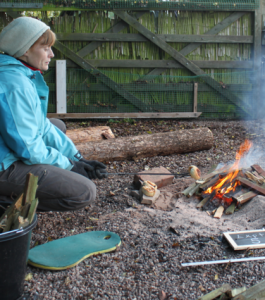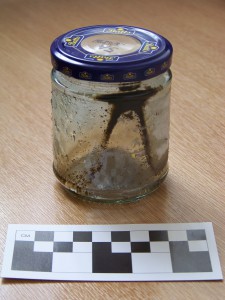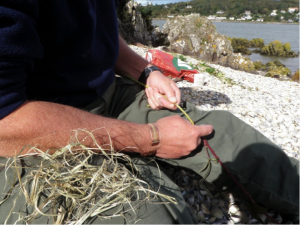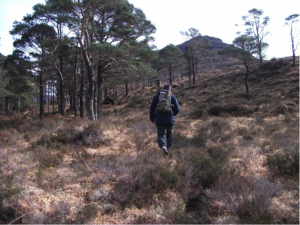For the last few years, I have been working with colleagues Peter Groom and Grethe Moéll Pedersen on the procurement of tar without using pottery. If you, like me, work with Stone age cultures, some things are more spectacular than others, and in this post I am going to introduce you to one of those – pieces of birch bark tar that may be up to 250 000 years old.
250 000 years ago, someone made and used birch bark tar in Central and Southern Europe, well before modern humans entered European history. The people who hafted their flint implements with tar, were Neanderthals: sturdy humans with stocky limbs and big brains well adapted to the cold climate of Europe. Neanderthals are technically called Homo neanderthalensis, first recovered in Neanderthal, Germany. They did, however, live as far east as Georgia and as far west as the Iberian peninsula.
Neanderthals had a complex stone technology centering around Levallois flakes: large-ish flint flakes with two sharp edges, often made into spear points or used as base for other tools.To make a Levallois flake demands a level of skill in flint knapping which is currently beyond my level. You first have to elaborately shape a piece of flint to resemble a tortoise shell, before you strike off the Levallois flake with a well-aimed blow. Around 250 000 years ago, someone made one and hafted it with birch bark tar to form an unknown implement, maybe a spear. This is the earliest find of birch bark tar that has ever been made, found at Campitello quarry, Italy. In Germany, a similar find has been made at Königsaue, but dated to c. 50 000 years ago.The site Inden-Altdorf in Germany also yielded 81 artefacts with tar specks all over, from 120 000 years ago; a number that indicates an ability to produce tar repeatedly and when needed.
But what is the big deal with this tar? Although it may not seem particularly impressive today, there are two reasons for why Neanderthal tar making is special: The only other artefacts we have recovered after this enormous amount of time are made of stone, and tar provides an interesting variation to the discussion. But more importantly, to make tar is actually a complex process that demands a carefully controlled temperature between c. 250-400°C, airtight environments, and a good plan. The fact that Neanderthals were making tar shows a skillful mastery of fire, an understanding of the concept of airtight (and therefore the concept of air), and an ability to plan and monitor a demanding process. This all credits Neanderthals with quite the intelligence!

Many researchers have tried, and most have failed, to make birch bark tar the way Neanderthals did. To achieve tar, you must force birch bark to undergo slow pyrolysis, where bark changes from mass to liquid (tar), gas (volatile, smelly fumes) and waste matter (char). From 6-7000 years ago onwards, the airtight conditions could easily be created by pottery. But before this, we have as of yet found no evidence for how the tar was made. Remains from a bonfire at Abric Romani in Spain, dated up to c. 70 000 years ago, shows evidence of a hydrocarbon spill, but that is all. Many have been puzzled by this mystery of production.
Peter, Grethe and I did 16 experiments with various pit structures in 2009, scratching our heads when structure after structure failed us. Peter and I went on to do a set of experiments with standing structures in 2013. And finally, we made it! We were beyond excited to see tar trickle out of the structures (even though it trickled down a precious piece of equipment..).

Basically, we had made tar in small heaps of sand, and all that remained was a spill of hydrocarbons in bonfire remains. But it did take us 5 years to get there! Boy, are we impressed with Neanderthals: We barely made it to their everyday level of thought, and I have, for sure, learnt to never call them primitive again.
Tine Schenck is an experimental archaeologist with a special interest in Boreal, seasonal exploitation of resources, and one of the founders of ArchaeologistsEngage. You can read more about the first experiments here.


